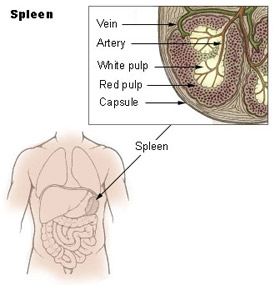Spleen

The spleen is located in the upper left abdominal cavity, just beneath the diaphragm, and posterior to the stomach. It is similar to a lymph node in shape and structure but it is much larger. The spleen is the largest lymphatic organ in the body. Surrounded by a connective tissue capsule, which extends inward to divide the organ into lobules, the spleen consists of two types of tissue called white pulp and red pulp. The white pulp is lymphatic tissue consisting mainly of lymphocytes around arteries. The red pulp consists of venous sinuses filled with blood and cords of lymphatic cells, such as lymphocytes and macrophages. Blood enters the spleen through the splenic artery, moves through the sinuses where it is filtered, then leaves through the splenic vein.
The spleen filters blood in much the way that the lymph nodes filter lymph. Lymphocytes in the spleen react to pathogens in the blood and attempt to destroy them. Macrophages then engulf the resulting debris, the damaged cells, and the other large particles. The spleen, along with the liver, removes old and damaged erythrocytes from the circulating blood. Like other lymphatic tissue, it produces lymphocytes, especially in response to invading pathogens. The sinuses in the spleen are a reservoir for blood. In emergencies such as hemorrhage, smooth muscle in the vessel walls and in the capsule of the spleen contracts. This squeezes the blood out of the spleen into the general circulation.
Suggested Citation
SEER Training Modules: Spleen. U.S. National Institutes of Health, National Cancer Institute. Cited 22 January 2026. Available from: https://training.seer.cancer.gov.




